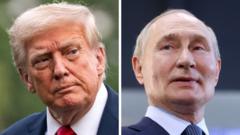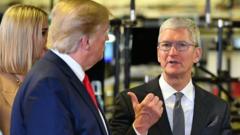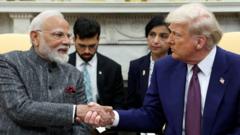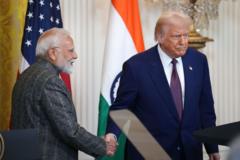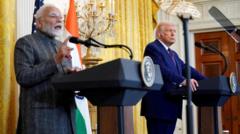In a bold move, President Donald Trump has rolled out sweeping tariffs impacting numerous countries around the globe, igniting a wave of reactions across international markets. Minutes before midnight in Washington, Trump proudly announced via social media, “IT'S MIDNIGHT!!! BILLIONS OF DOLLARS IN TARIFFS ARE NOW FLOWING INTO THE UNITED STATES OF AMERICA!”
Trump Unleashes New Tariffs: Global Economies Brace for Impact

Trump Unleashes New Tariffs: Global Economies Brace for Impact
New tariffs implemented by President Trump signal a seismic shift in international trade dynamics.
The tariffs, which include a significant 50% levy on Indian imports set to begin on August 27—pending India's decision on purchasing Russian oil—along with a potential 100% tax on foreign-made computer chips, are part of Trump's strategy to encourage domestic manufacturing. This comes as tech giant Apple has committed to a massive $100 billion investment in the U.S., likely influenced by pressure from the administration to boost local production.
The Trump administration's recent announcements have outlined a revised tariff framework, extending deadlines for negotiations with trading partners to August 7. Numerous countries have been scrambling to secure deals to mitigate the impact of what Trump defines as “reciprocal tariffs.” Export-reliant nations, particularly in Southeast Asia, are among the first to feel the brunt of these changes, with manufacturing-intensive Laos and Myanmar facing tariffs as high as 40%.
While some larger economies such as the UK, Japan, and South Korea have reached agreements to lower tariffs, the European Union has consented to a 15% import tax on its goods. Taiwan, a strategic ally for the U.S., has been assigned a temporary 20% tariff, with ongoing discussions expected to reduce this rate further.
The Canadian government reported that although the U.S. has raised its tariff on Canadian imports from 25% to 35% over drug-related concerns, most Canadian goods will still be shielded from tariffs under the pre-existing United States-Mexico-Canada Agreement (USMCA). Meanwhile, negotiations with Mexico regarding tariff increases have been extended for an additional 90 days.
In a significant statement earlier this week, Trump unveiled plans for a staggering 100% tariff on foreign semiconductors, albeit major chip manufacturers that have invested heavily in the U.S. may escape these new penalties. The White House has yet to clarify the specifics of these exemptions, and inquiries to key companies like TSMC, SK Hynix, and Samsung have gone unanswered.
India has vocally opposed the newly imposed tariffs, deeming them “unfair, unjustified, and unreasonable,” while asserting its commitment to safeguard national interests. Brazil faces a similar hike, facing a 50% tariff due to allegations from Trump against President Luiz Inacio Lula da Silva regarding his treatment of U.S. technology firms.
As talks continue between the U.S. and China to possibly extend an existing 90-day tariff pause, the global economy watches closely, anticipating the repercussions of these bold moves by the Trump administration.
Economic analysts remain on high alert as this situation evolves, foreseeing both shock and opportunities for adaptation in the fast-changing international trade landscape.
The Trump administration's recent announcements have outlined a revised tariff framework, extending deadlines for negotiations with trading partners to August 7. Numerous countries have been scrambling to secure deals to mitigate the impact of what Trump defines as “reciprocal tariffs.” Export-reliant nations, particularly in Southeast Asia, are among the first to feel the brunt of these changes, with manufacturing-intensive Laos and Myanmar facing tariffs as high as 40%.
While some larger economies such as the UK, Japan, and South Korea have reached agreements to lower tariffs, the European Union has consented to a 15% import tax on its goods. Taiwan, a strategic ally for the U.S., has been assigned a temporary 20% tariff, with ongoing discussions expected to reduce this rate further.
The Canadian government reported that although the U.S. has raised its tariff on Canadian imports from 25% to 35% over drug-related concerns, most Canadian goods will still be shielded from tariffs under the pre-existing United States-Mexico-Canada Agreement (USMCA). Meanwhile, negotiations with Mexico regarding tariff increases have been extended for an additional 90 days.
In a significant statement earlier this week, Trump unveiled plans for a staggering 100% tariff on foreign semiconductors, albeit major chip manufacturers that have invested heavily in the U.S. may escape these new penalties. The White House has yet to clarify the specifics of these exemptions, and inquiries to key companies like TSMC, SK Hynix, and Samsung have gone unanswered.
India has vocally opposed the newly imposed tariffs, deeming them “unfair, unjustified, and unreasonable,” while asserting its commitment to safeguard national interests. Brazil faces a similar hike, facing a 50% tariff due to allegations from Trump against President Luiz Inacio Lula da Silva regarding his treatment of U.S. technology firms.
As talks continue between the U.S. and China to possibly extend an existing 90-day tariff pause, the global economy watches closely, anticipating the repercussions of these bold moves by the Trump administration.
Economic analysts remain on high alert as this situation evolves, foreseeing both shock and opportunities for adaptation in the fast-changing international trade landscape.

